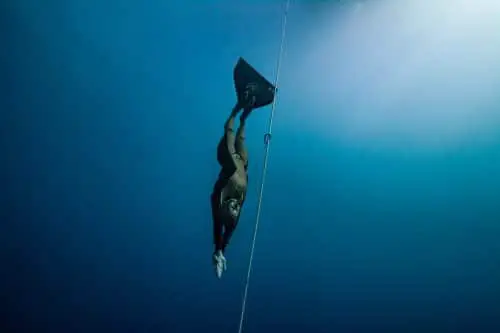When we think of scuba divers, we imagine people clad in the full setup of wetsuits, oxygen tanks, flippers, and a full face mask for scuba diving. However, what if I was to tell you that there are people out there that choose to not use any of that gear- aside from the wetsuit. This may seem shocking to you, but there is an entire group of people known as free divers who depend on nothing but a single breath when exploring the depths of the ocean. But what is freediving and how do you do it?
What is Freediving?

Freediving is the art of diving while only using a single breath. This contradicts what most scuba divers have always been told, which is that breathing is key to successfully diving and avoiding any driving ailments such as the bends. However, before introducing any scuba gear and technology, humans have been diving for years without any assistance. So that begs the question, how are some people capable of holding their breath underwater when the rest of us depend on scuba gear to investigate the water’s depths?
Practice
As I previously stated, being able to breathe underwater is an ability that all humans have. However, some of us have never pushed the limitations of how far we can really hold our breath. Freedivers prefer the experience of being able to move freely through the water without having to use an oxygen tank and mask and so they have picked up special techniques that allow them to hold their breath for longer.
Lung Packing
The main technique that freedivers use when trying to hold their breath for an extended period of time is lung packing. This technique basically consists of taking the deepest breath you can, closing your throat, and then inhaling once again and filling the cheeks. When in the water, the freediver will use a pushing technique, which means they push the air that they have held in their mouth into their lungs. This acts much like how using an oxygen tank would work, but with a much more finite resource.
The trick is to trickle a resource of oxygen into your lungs, but if you are a woman then the most you can carry in your lungs at a time is 4 liters, whereas a man could carry around 6 liters. This is practiced repeatedly before even touching the water and through gradual training, freedivers are capable of swimming without gear for longer than you may think.
How long can Free Divers Hold their Breath for?
Though they can hold their breath for much longer than the average person, a free diver still has limitations on how long they can hold their breath. Women have a lower lung capacity than men so can hold their breath for around 9 minutes when freediving, whereas men can hold their breath for around 11 minutes. However, it really depends on the person as people are capable of more than that when they have done the right training. However, they also need to be extremely careful to not starve their brain of oxygen for too long, as this could lead to brain damage or even death.
What equipment do they use?

Though they do not use masks and oxygen tanks when diving, freedivers do use other forms of equipment when diving to help them with their task. They use the common equipment that is often used in diving, such as flippers and also wetsuits or rash guards. For the freedivers that try to be as natural as possible, they favor using rash guards. However, people often wonder if this is the best call and ask ‘do rash guards keep you warm when you are in the water?’. This may be something that you need to worry about when you’re spending an extended amount of time underwater, but when you are freediving you are never in the water for more than 15 minutes so staying warm isn’t really a concern. However, rash guards work much like swimsuits and do in fact keep you warm when you are in the water, which is good for freedivers as it means they are not using valuable resources trying to stay warm.
Other equipment
When freediving, it is important to have as much help as you can to make sure that you have an easy descent and ascent. If they are under a time crunch and need to descend quickly, freedivers will often use weighted items to help them reach the bottom faster. This will also mean that they can stay immobile while descending, which means they aren’t unnecessarily exhausting some of their valuable oxygen resources.
Some freedivers will also use buoyancy devices to help them ascend back to the surface of the water. These devices can usually be triggered when under the water and means that the freediver will naturally start to resurface without having to use too much of their own energy.
The Depth
Though freedivers are capable of reaching similar depths as people who are using equipment, they really need to limit themselves in how deep into the water they go. This is because as you reach lower depths, you require more oxygen. Due to the limitations in oxygen that you do have, most people who do freedivers choose not to go further than 30 meters down. At this point, the pressure from the water begins to constrict your breathing and forces you to use more of your oxygen resources.
How do you start Freediving?
Out of all of the aquatic activities that you can do, freediving is something that you can not learn alone. This is due to a number of safety concerns, along with the fact that you have to learn a long line of techniques to make sure that you do it safely.
